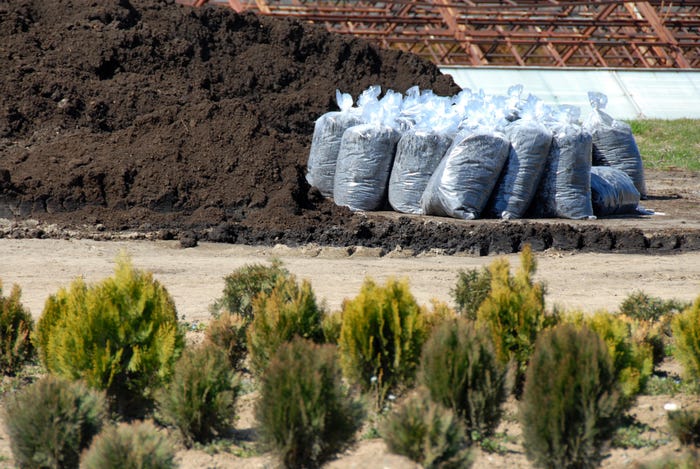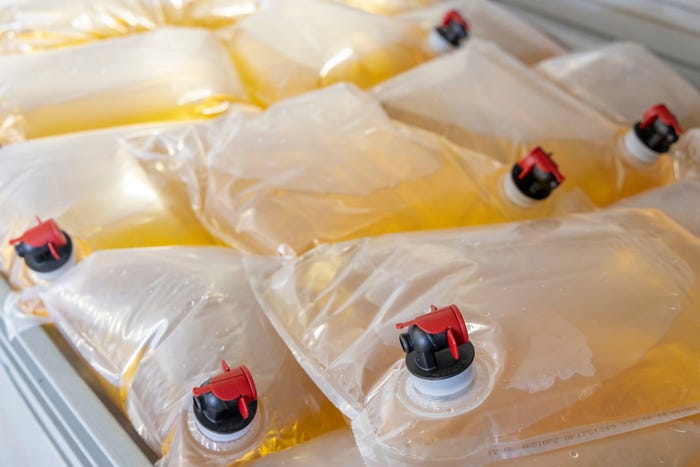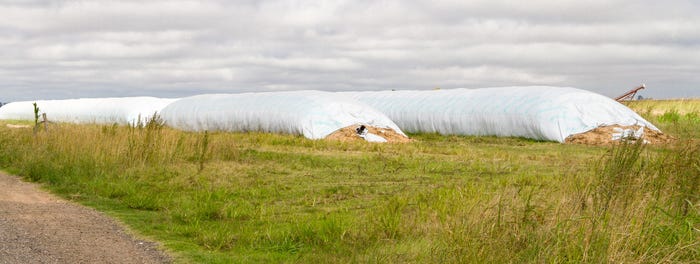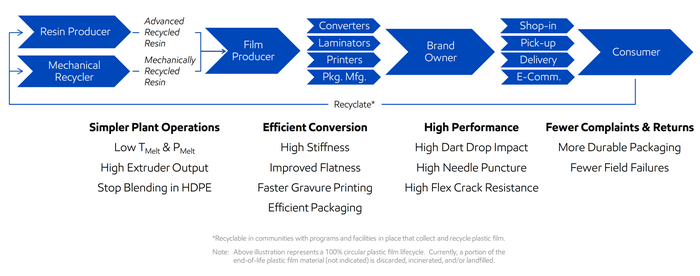ExxonMobil's new Exceed S performance polyethylene (PE) helps flexible packaging and film converters simplify designs, improve performance, and produce more durable products.
May 10, 2022

Sponsored by ExxonMobil
Tom Miller
Flexible film design is fraught with compromise and complexity. Designers use their skills to select resins offering a satisfactory balance of mechanical performance and easy extrusion. Then they try to overcome deficiencies by blending low amounts of other resins or increasing layer count to meet final product performance requirements. The complex operations involved in producing and converting these multi-resin, coextruded structures into printed, durable packaging is thereby prone to inefficiency, scrap and human error.
Switching from film production to industry trends, the growth of e-commerce increases package performance and durability requirements, and brand-owner’s desire to incorporate higher percentages of recycled content heightens the need for premium resins that help designers do more with less.
These new resins use the latest innovations in catalyst and polymer science to deliver the toughest and stiffest resins possible to help reduce the need to blend, help simplify plant operations, and help improve film performance and package durability for brand owners and the end-user.
Examining complexity challenges in film design.
The fundamental difficulty when designing and producing high performance flexible films is to maximize performance while minimizing resin and layer count. Compromises, such as the well-known tradeoff between mechanical performance and ease of processing, make this challenging.
Consider the case of a cost-effective, three-layer, Ziegler-Natta based, linear low-density polyethylene (ZN LLDPE) structure. Typically, such film designs have relatively low toughness, and so a film designer might take the following sequential steps to deliver higher performance:
Upgrade to a metallocene linear low-density polyethylene (mLLDPE), which will significantly increase film toughness — with some sacrifice to processing, stiffness, and optics (e.g., clarity, gloss).
Restore some of that lost stiffness by adding high-density polyethylene (HDPE) to the core layer — at some sacrifice to toughness.
Add high-pressure low-density polyethylene (LDPE) to the skins for higher melt strength, higher output, improved optics, and easier processability —with some sacrifice to toughness.
It becomes apparent that efforts to achieve an acceptable balance of higher performance become increasingly complex as more resins, blends, and performance compromises ensue. Furthermore, real world issues like the manpower and equipment involved in staging, feeding, and processing the more complicated operation increase the likelihood of reliability induced downtime, unintended human error, and associated production inefficiencies and losses.
Simplified solutions.
Simpler solutions that can help reduce complexity and lessen compromise are now commercially available with the introduction of Exceed™ S performance PE from ExxonMobil. Combining advanced product and process technologies aligned with needs identified through years of close collaboration with our customers has led to the development of these stiff, tough, easy processing resins. The performance is such that lean blends of up to 20% HDPE in LLDPE can oftentimes be replaced, depending on the resins used in the preexisting structure and the needs of a given application.
When used in the core layer of a coextruded multi-layer flexible pouch, these new performance polymers serve as a stiff, tough, functional layer enabling the use of lower density skin resins to further optimize package sealing and performance with comparable stiffness. However, some applications benefit more from skins made of Exceed S performance PE, where the core layer can then be used to accommodate other must-have resins. Regardless of which layer the resins are used in, the high melt strength, low melt pressure, and high output, relative to other metallocene-based LLDPE resins, can help reduce the need to add LDPE to enhance processing.
During development, high-frequency dart-drop impact tests, and in cases, needle puncture tests, showed stiffness and toughness benefits beyond market references; and laboratory extruder tests simulating production by a converter verified higher output levels and lower melt pressures than market references. Success in the laboratory has led to the commercial launch of three grades of the new Exceed S performance PE designed to run on most blown film lines, including those limited by melt pressure or melt temperature. One of the grades can also be processed on some cast lines.
Three grades of Exceed S performance PE are commercially available globally. Key properties are shown below:c

100 collaborations and counting.
Market interest has been strong during development with active collaborations underway with more than 75 converters evaluating the resin in more than 100 applications globally. In addition, our own internal testing has shown many advantages relative to market references, including:
Non-laminated pouches, medium duty sacks and stand-up pouches for liquid and solid goods; used in the core layer to eliminate HDPE and improve durability without losing stiffness (as discussed above).
Sealant webs for laminated pouches, particularly PE//PE liquid and solid filled pillow pouches made using machine direction orientation (MDO) print webs; used in the core layer of the sealant web to enhance toughness and durability.
Heavy duty sacks for polymer resin, agricultural and industrial bags weighing 25 to 50 kilograms; used in core and skins to produce film offering excellent tear and stiffness with less HDPE added. Shown below:

Hot-filled bag-in-boxes for liquid packaging with coextruded bladder and spout; used in skin layers to reduce flex-cracking and blocking via higher seal initiation temperature (SIT). Shown below:

Agricultural silo bags such as large-format horizontal grain storage bags; used in both core and skins to enhance machine direction tear, transverse direction creep resistance, dart impact, and needle puncture in a film that is 6% thinner. Shown below:

Air tube bags for shipping goods via e-commerce; used in the skins of polyamide-containing coex structures to improve needle puncture in a film that is 17% thinner or uses 10% less polyamide but delivers comparable performance.
A more efficient value chain.
Exceed S performance PE resins offer potential savings at each step of the flexible packaging and industrial films value chain. Thanks to industry-leading combinations of stiffness and toughness paired with easy processing and the potential for higher extrusion output, these resins can help simplify plant operations. The good melt strength and inherently high stiffness can help produce smooth, flat, low extensibility films that can help improve conversion efficiency. Similarly, the combinations of high stiffness, dart drop impact, and puncture resistance help enhance film toughness and create opportunities to further improve final package and industrial film durability.
Exceed S performance PE offers potential savings at each step in the value chain, as shown below:

For more information on Exceed S performance polyethylene, please download a white paper titled, “Rethinking flexible film design for simpler solutions and a more efficient value chain.”
About the author
 Tom Miller is currently Marketing Manager for Exceed S Performance Polyethylene at ExxonMobil Product Solutions Co. For more than 25 years, Tom has been responsible for the development, marketing, and deployment of new polyolefin products while working collaboratively with customers to improve the performance and value of their applications. Twenty-three of those years have been spent in technology, marketing, and manufacturing leadership at ExxonMobil. Today, Tom applies those skills to the launch and growth of the Exceed S performance PE platform. Tom has a B.S. in Ceramic Engineering from the University of Missouri-Rolla and an M.S. and PhD. in Polymer Science from the University of Florida.
Tom Miller is currently Marketing Manager for Exceed S Performance Polyethylene at ExxonMobil Product Solutions Co. For more than 25 years, Tom has been responsible for the development, marketing, and deployment of new polyolefin products while working collaboratively with customers to improve the performance and value of their applications. Twenty-three of those years have been spent in technology, marketing, and manufacturing leadership at ExxonMobil. Today, Tom applies those skills to the launch and growth of the Exceed S performance PE platform. Tom has a B.S. in Ceramic Engineering from the University of Missouri-Rolla and an M.S. and PhD. in Polymer Science from the University of Florida.
You May Also Like


